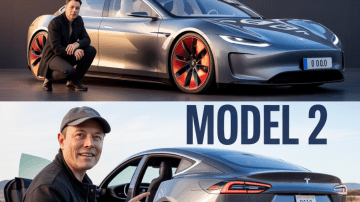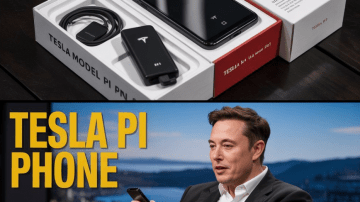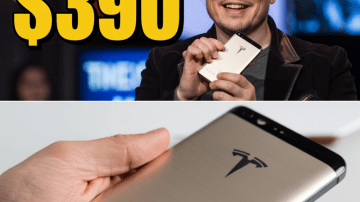By Grok News Desk | September 20, 2025
In the heart of Austin, Texas, under the glare of spotlights and the hum of anticipation, Elon Musk stepped onto the stage at Tesla’s sprawling Gigafactory. The year was 2025, and the world was already reeling from the electric revolution—self-driving cars zipping through cities like ghosts, rockets piercing the stars, and neural implants whispering thoughts into machines. But nothing, nothing, could have prepared the tech universe for what came next. With a trademark smirk and a single, seismic announcement, Musk unveiled the Tesla Pi Phone: a sleek, satellite-powered marvel that integrates SpaceX’s Starlink network right into your pocket. And the kicker? It’s priced below $175. Yes, you read that right—under $175 for a device that’s set to obliterate the smartphone status quo.

Picture this: You’re stranded in the middle of the Sahara Desert, no cell towers for miles, your iPhone’s battery gasping its last breath. With the Pi Phone, you’d fire up a holographic call to your boss, stream 4K videos from orbit, and charge the whole thing using nothing but the sun’s rays. Musk didn’t just reveal a phone; he ignited a rebellion against the trillion-dollar titans of Silicon Valley. “We’ve been held hostage by overpriced gadgets that lock us into endless upgrade cycles,” Musk thundered to a crowd of 10,000 roaring fans, their cheers echoing like thunder across the Texas plains. “The Pi Phone isn’t just a device—it’s freedom. Global, unbreakable freedom, for less than the cost of a decent dinner out.”
The reveal wasn’t some quiet press release tucked away in a footnote. No, this was pure Elon theater. As the lights dimmed, a massive screen flickered to life, projecting a cascade of stars—literal footage from Starlink satellites orbiting 340 miles above Earth. Then, slicing through the cosmic backdrop, a prototype Pi Phone descended from the rafters on a drone, its titanium frame glinting like a fallen meteor. Gasps rippled through the audience as Musk snatched it mid-air, holding it aloft like Excalibur. “This,” he declared, “is the future of connectivity. No more dead zones. No more data caps. And no more paying a king’s ransom for the privilege.”
Let’s rewind a bit, because to understand the shockwaves this announcement sent, you need the backstory—the rumors, the leaks, the feverish speculation that had tech forums ablaze for years. It all started back in 2021, when Musk tweeted a cryptic emoji salad: a phone, a rocket, and a pi symbol. Fans decoded it as a hint at the “Tesla Pi Phone,” a nod to the mathematical constant pi (3.14…) and perhaps a sly dig at Apple’s closed ecosystem. Whispers grew louder in 2023, fueled by patent filings for “portable satellite communication devices” under SpaceX’s umbrella. By 2024, insiders were buzzing about prototypes tested in the Nevada desert, where engineers allegedly made crystal-clear Zoom calls from the depths of Area 51-adjacent badlands.
Skeptics dismissed it as vaporware—Musk’s flair for hype often outpaces delivery, remember the Cybertruck’s “unbreakable” windows that shattered on demo day? But this time, the man backed it up. At the event, he paraded a who’s-who of collaborators: Gwynne Shotwell from SpaceX detailing the Starlink antenna tech, a Neuralink engineer demoing brainwave controls, and even a surprise cameo from a Falcon 9 rocket component supplier, revealing that the phone’s chassis is forged from recycled rocket-grade alloys—lightweight, indestructible, and eco-friendly to boot.

So, what makes the Pi Phone a world-shocker? Buckle up, because the features read like sci-fi come to life, all engineered to hook you from the first swipe.
First and foremost: Starlink Integration. Forget fumbling for Wi-Fi in a black hole of coverage. The Pi Phone’s built-in phased-array antenna latches onto Starlink’s constellation of over 6,000 low-Earth orbit satellites, delivering download speeds up to 500 Mbps—anywhere on the planet. Musk demoed it live: tossing the phone into a simulated “dead zone” (a Faraday cage blocking all terrestrial signals), he then pulled up a live feed from the International Space Station, chatting with an astronaut as if they were next door. No SIM card needed; it’s direct-to-satellite magic. For the 3 billion people worldwide still offline, this isn’t just a feature—it’s a lifeline. Digital nomads, disaster responders, and off-grid adventurers? They’re already lining up virtual queues.
But Musk didn’t stop at connectivity. Enter Solar X1 Charging: A photovoltaic film embedded in the phone’s rear panel that harnesses sunlight to generate up to 40% of its daily power needs. In the demo, Musk left the device baking under stage lights for 10 minutes, then powered through a full day of heavy use—streaming, gaming, AI queries—without plugging in once. “Why tether yourself to walls when the sun’s free?” he quipped. It’s not gimmicky; it’s genius for a warming world where power outages are the new normal.
Then there’s the Neuralink Compatibility, the feature that’s got ethicists and futurists in a tizzy. For those with the Neuralink implant (now in human trials since 2024), the Pi Phone acts as a seamless brain interface. Think: controlling your playlist with a thought, or dictating emails via neural pulses. Musk waved off privacy concerns with a wave: “Your thoughts are yours; we’re just the bridge.” Early adopters—about 50 Neuralink users invited to the event—gave it a standing ovation after a live mind-controlled demo, where one participant “drew” a Tesla logo in mid-air using nothing but brainwaves projected on the big screen.

Security? The Pi Phone laughs at hackers. Its QuantumShield Encryption leverages Starlink’s satellite backbone for unbreakable, space-based keys—rendering traditional cyberattacks obsolete. Musk illustrated with a hack attempt on stage: a “white-hat” team tried breaching a dummy iPhone while the Pi Phone repelled them effortlessly, its AI even counter-tracing the attack back to the demo laptop. Add Military-Grade Anti-Theft, which uses orbital tracking to brick the device if stolen, and you’ve got a fortress in your fist.
Design-wise, it’s pure Tesla minimalism meets cyberpunk flair. At 210 grams, the Pi Phone feels like holding a feather-wrapped brick of innovation. The 6.8-inch OLED display boasts self-healing nano-tech—scratches vanish like morning mist under UV exposure. A subtle Tesla “T” logo on the back glows with Starlink patterns in low light, turning heads at night. Colors? Cyber Red, Starship Silver, and Neural Black—each screaming “future is here.”
And the cameras? A triple-lens setup with 108MP main sensor, AI-enhanced low-light wizardry (powered by Tesla’s Full Self-Driving vision tech), and a macro lens that doubles as a microscope for on-the-go science nerds. Video calls? Holographic projections beam 3D avatars across the room, making FaceTime look like cave paintings.
Now, the elephant in the room—or rather, the wallet-friendly pachyderm: How the hell is this under $175? Apple’s iPhone 17 just dropped at $1,199, Samsung’s Galaxy S25 Ultra isn’t far behind at $1,299. Musk’s secret sauce? Vertical integration on steroids. By manufacturing in Tesla’s U.S. factories (hello, tax breaks and automation), sourcing Starlink chips directly from SpaceX, and skipping the bloat of carrier subsidies, costs plummet. “We’re not in the luxury game,” Musk explained. “We’re democratizing tech. This phone pays for itself in the first year by ditching data plans—Starlink’s baked in, unlimited.”
The ripple effects? Cataclysmic. Apple shares dipped 8% in after-hours trading, Tim Cook’s war room undoubtedly scrambling for a “Satellite Lite” response. Samsung and Google? They’re dusting off their own orbital dreams. But beyond stocks, the Pi Phone could bridge the digital divide: Imagine rural farmers in India streaming crop advice via satellite, or refugees in war zones coordinating aid without borders. Environmentalists love the recycled materials; 80% of the body is upcycled from Falcon 9 debris, closing the loop on space waste.

Of course, it’s not all utopia. Critics pounced immediately—Reddit threads exploded with “Starlink for phones? Physics says no!” skeptics, pointing out the power-hungry antennas and regulatory hurdles for global satellite beaming. Battery life under full Starlink throttle? Expect 12 hours, not 24. And Neuralink? That’s opt-in for the bold, with FDA approvals still pending for mass rollout. Musk addressed it head-on: “Perfection is the enemy of progress. This is version 1.0—evolve with us.”
As the event wound down, with fireworks spelling “PI” across the Austin sky, Musk left the crowd with a teaser: “Pre-orders open Monday. But hurry—first million units ship in Q1 2026.” The line outside the venue stretched for blocks, fans chanting “Elon! Elon!” like rock gods. Social media? A tsunami: #PiPhone trended worldwide within minutes, memes of crying Tim Cook flooding TikTok, and even President Harris tweeting congratulations (with a subtle nudge for “Made in America” tariffs).
In the days since, the buzz hasn’t faded—it’s amplified. Tech analysts predict 500 million units sold in year one, eclipsing the iPhone’s launch frenzy. Venture capitalists are circling for Pi Phone apps; educators eye it for global classrooms. And for the everyday dreamer? It’s validation that innovation doesn’t have to bankrupt you.
Elon Musk didn’t just shock the world with the Tesla Pi Phone—he redefined it. In a sea of incremental upgrades, this is disruption incarnate: affordable, audacious, and utterly addictive. Will it live up to the hype? History says bet on Musk. But one thing’s certain: Your next phone call might just come from the stars. And at under $175, who’s saying no?






